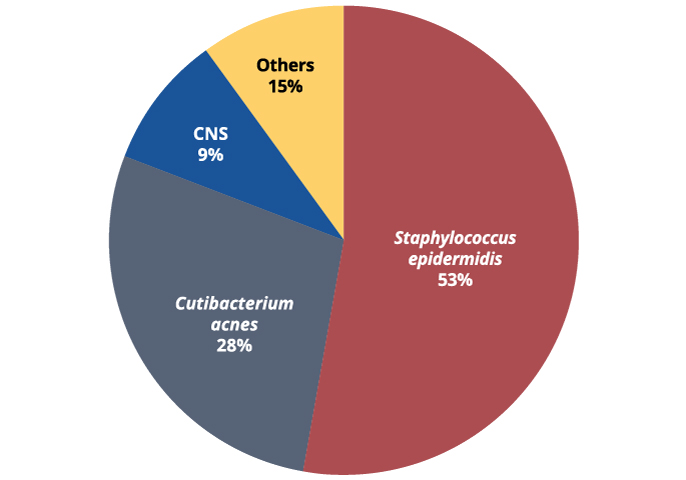qPCR+NGS Supplement Culture in Capsular Contracture (CC) and Suspected Breast Implant Infection Management
qPCR+NGS can more accurately identify polymicrobial involvement in CC
Bacterial contamination of implanted devices has been shown to frequently result in the formation of biofilms. A biofilm’s protective structure, and the state of bacteria within it, prevent traditional culture techniques from adequately characterizing the constituent species in biofilms — or even growing them at all.
A recent study published in Aesthetic Surgery Journal examined the microbiome of 32 CC patients using MicroGenDX qPCR+NGS testing. Results indicated a diverse and complex CC microbiome, suggesting the importance of considering personalized antimicrobial treatment for each patient.
While culture detected S. epidermidis, C. acnes and CNS as the primary microbes, the species most frequently isolated by NGS included (in order of relative abundance):
- E. coli
- Diaphorobacter nitroreducens
- C. acnes
- S. epidermidis
- Several unique fungal species, and
- S. aureus
Other limitations of culture
Culture may provide a preferential medium for certain microbes, leading to inaccurate identification of the causative organism, or to a polymicrobial infection being missed altogether.
In addition, bacteria adaptation can result in culture identification evasion. For example, in the case of viable but nonculturable bacteria (VBNC), known pathogens are capable of entering and resuscitating from a VBNC state without losing their virulence. During the VBNC state, microbes maintain their cellular structure, biology, and significant gene expression — which allows detection by molecular testing. However, while they are in a VBNC state, these pathogens are not culturable by standard laboratory methods.
Instead of relying only on either culture or NGS, why not use both to maximize the probability of treatment success? NGS has high concordance with traditional culture — 96% based on a 2018 study published in the Bone and Joint Journal — and higher sensitivity than culture. In a study of 168 chronic wounds, molecular testing was 20 times more sensitive, and in the majority of the samples, culture underreported the diversity of wound microbiota and failed to detect the most abundant bacteria present in the wound.
Read wound studyReferences
- Cook J, Holmes C J, Wixtrom R, et al. Characterizing the Microbiome of the Contracted Breast Capsule Using Next Generation Sequencing. Aesthet Surg J. 2021 Mar 12;41(4):440-447. doi: 10.1093/asj/sjaa097.
- Song J H, Kim Y S, Jung B K, et al. Salvage of Infected Breast Implants. Arch Plast Surg. 2017 Nov;44(6):516-522. doi: 10.5999/aps.2017.01025.
- Seng P, Bayle S, Alliez A, et al. The microbial epidemiology of breast implant infections in a regional referral centre for plastic and reconstructive surgery in the south of France. Int J Infect Dis. 2015 Jun;35:62-6. doi: 10.1016/j.ijid.2015.04.010.
- Tarabichi M, Shohat N, Goswami K, et al. Diagnosis of Periprosthetic Joint Infection: The Potential of Next-Generation Sequencing. J Bone Joint Surg Am. 2018;100(2):147-154.
- Ramamurthy T, Ghosh A, Pazhani G P, Shinoda S. Current Perspectives on Viable but Non-Culturable (VBNC) Pathogenic Bacteria. Front Public Health. 2014; 2: 103.
- Li L, Mendis N, Trigui H, et al. The importance of the viable but non-culturable state in human bacterial pathogens. Front Microbiol. 2014 Jun 2;5:258. doi: 10.3389/fmicb.2014.00258.
- Rhoads DD, Wolcott R D, Sun Y, Dowd SE. Comparison of Culture and Molecular Identification of Bacteria in Chronic Wounds. Int. J. Mol. Sci. 2012, 13, 2535-2550; doi:10.3390/ijms13032535



 Implant Infections
Implant Infections Challenging Surgical Sites
Challenging Surgical Sites Explant Candidates
Explant Candidates